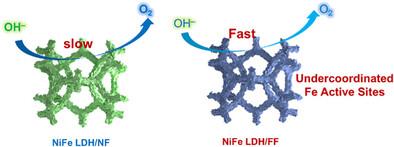Corrosion Strategy‐Induced Undercoordinated Fe Active Sites in NiFe LDH for Alkaline Water Oxidation
IF 12.1
2区 材料科学
Q1 CHEMISTRY, MULTIDISCIPLINARY
引用次数: 0
Abstract
The electrochemical restructuring of nickel‐iron layered double hydroxide (NiFe LDH) into high‐oxidation‐state Ni/Fe oxyhydroxide is crucial for the alkaline oxygen evolution reaction (OER). Nevertheless, the sluggish self‐reconstruction kinetics including high energy barriers and complex phase‐transition dynamics of NiFe LDH significantly restrict its electrocatalytic performances. Herein, an oxygen vacancy‐rich NiFe LDH decorated on iron foam (FF) is synthesized through a corrosion strategy. The corrosion process provides undercoordinated active sites in NiFe LDH/FF for OER. In alkaline electrolytes, NiFe LDH/FF displays an exceptional OER activity (a mere 254 mV overpotential with a Tafel slope of 51.7 mV dec

腐蚀策略-诱导NiFe LDH碱性水氧化中铁活性位不协调
镍-铁层状双氢氧化物(NiFe - LDH)的电化学重组为高氧化态的Ni/Fe氢氧化物是碱性析氧反应(OER)的关键。然而,NiFe LDH缓慢的自重建动力学(包括高能量垒和复杂的相变动力学)严重限制了其电催化性能。本文通过腐蚀策略在泡沫铁(FF)表面合成了富氧空位的NiFe LDH。腐蚀过程在NiFe LDH/FF中为OER提供了不协调的活性位点。在碱性电解质中,NiFe LDH/FF表现出优异的OER活性(过电位仅为254 mV, Tafel斜率为51.7 mV dec - 1),并且在500 mA cm - 2下100小时内具有出色的稳定性。综合实验和理论计算进一步表明,活性位不协调的NiFe LDH/FF有利于电化学重构为高活性的NiOOH和FeOOH相。NiFe LDH/FF中的Fe活性位点可以有效降低氧中间体的吸附强度,从而改变OER过程中由(O*→OOH*)到(OH*→O*)的速率决定步骤,降低其反应能垒。本研究提出了一种通过腐蚀策略和缺陷工程设计低能耗OER电催化剂的创新策略。
本文章由计算机程序翻译,如有差异,请以英文原文为准。
求助全文
约1分钟内获得全文
求助全文
来源期刊

Small
工程技术-材料科学:综合
CiteScore
17.70
自引率
3.80%
发文量
1830
审稿时长
2.1 months
期刊介绍:
Small serves as an exceptional platform for both experimental and theoretical studies in fundamental and applied interdisciplinary research at the nano- and microscale. The journal offers a compelling mix of peer-reviewed Research Articles, Reviews, Perspectives, and Comments.
With a remarkable 2022 Journal Impact Factor of 13.3 (Journal Citation Reports from Clarivate Analytics, 2023), Small remains among the top multidisciplinary journals, covering a wide range of topics at the interface of materials science, chemistry, physics, engineering, medicine, and biology.
Small's readership includes biochemists, biologists, biomedical scientists, chemists, engineers, information technologists, materials scientists, physicists, and theoreticians alike.
 求助内容:
求助内容: 应助结果提醒方式:
应助结果提醒方式:


